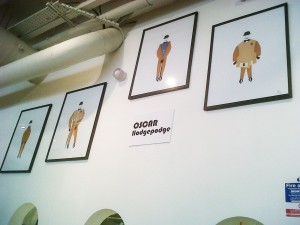It’s interesting to think that in this day and age many people still debate the relationship between fashion and art, whether there’s an intrinsic link between the two, whether one is artistically superior to the other, whether one is less governed by commercial concerns than the other etc. For me, the two forces are inseparable, art providing endless inspiration to designers, while the work of designers is often portrayed in new and exciting ways by those of a different discipline.
Take, for example, illustrator, Richard Kilroy, who often re-interprets runway menswear designs to fashion minimalist images which are both stark and subtly beautiful (see column on right).
Or Hormazd Narielwalla, who recently exhibited at London’s The Shop at Bluebird. Narielwalla, who previously exhibited at the Scope Art Fair in NYC’s Lincoln Centre (which was curated by none other than fashion blogging maven, Diane Pernet), made his London debut with a collection of photographic-collage artworks entitled, Oscar Hodgepodge – a modest and yet striking take on the archetypal English dapper, moustached man. Having seen the works while browsing through the store, I couldn’t help but get in touch and ask for this astute artist’s interpretation.
What is Oscar Hodgepodge about?
I imagined London – 100 years ago and listened to the sounds of well-heeled footsteps on cobblestone punctuated by the clicking point of a rolled umbrella. This evoked a mist of tenuously attributed nostalgia. I collected fragmented memories of old films, people, and places, which condenses to find form in a particular gentleman, Mr. Oscar Hodgepodge, whose shifting shape is haphazardly collaged from bespoke Savile Row patterns discarded after the death of a customer, utterly useless, abandoned until found whilst working for Savile Row military tailors, Dege & Skinner. The immaculate outlines of unused patterns accentuate a quintessentially English Englishman whose stiffness trips all too easily from formality to folly. A revenant rising from redundant remnants, Oscar is a hodgepodge held together by my longing to remember the forgotten.
What is your artistic background?
I successfully completed a Masters in Fashion Enterprise & Design at Westminster under British designers Shelley Fox and Zowie Broach of Boudicca. I was interested in fashion as a process but found it challenging working with cloth. I was lucky indeed to then work for the prestigious Savile Row civil, military and sporting tailor, Dege & Skinner, where I developed an appreciation for bespoke tailoring; in particular, the cutters’ all-important brown paper patterns of individual customers. This fascination, coupled with my creative interpretation of the patterns, prompted me to produce a limited edition book entitled, Dead Man’s Patterns. This artistic design story was inspired by a set of bespoke patterns belonging to a deceased customer. The concept was an attempt to recreate the patterns as objects of art, using the unique theme, which has become my trademark.

Did you study illustration?
As a student on both my Bachelors and Masters course I was given drawing/illustration lessons, amongst various aspects of design. My mentors Zowie Broach and Shelley Fox brought to my attention that my visuals were strong; they could become pieces of art and decided to express my research concepts in a 2D form.
I forage for forms in historic tailoring archives and reveal previously untold stories. I utilise photography, my own sketches and digital composition collages to create these sets of playful artworks. In October 2009, Paul Smith presented my first solo exhibition at his gallery on Albemarle Street, in London’s Mayfair entitled A Study on Anansi where I combined the patterns with western African folk tales. For my NY show I used the late operatic-pop artist Klaus Nomi as inspiration and again used the patterns as pieces of his body. I have also recently written and art directed my second publication, the tailoring memoirs of Michael Skinner, master cutter and chairman of Dege & Skinner, whose story is told through the pattern cutting journals Mr. Skinner compiled when studying at the Tailor & Cutter Academy – this is due to be published in 2010.




